论文格式要求
论文格式要求

论文的结构•标题•摘要•关键词•引言(可以没有)•正文•参考文献具体格式如下:正文1、层次代号的格式如下:一级标号:1 ×××或一、×××二级标号:1.1 ×××或(一)×××三级标号:1.1.1 ×××或1、×××2、论文字体、字形及字号要求(1)层级字体、字形一级标题:1. ×××或一、×××小三号宋体加粗二级标题:1.1 ×××或(一)×××四号宋体字加粗三级标题:1.1.1 ×××或1、×××小四号宋体字加粗正文××××小四号宋体下级标题的显目程度不超过上一级,不重复或混淆。
标题一律采用顶格。
(2)图表标号:图:1-1 图:1-2 图:1-3 图:2-1 图:2-2 图:2-3……(标在图正下方)宋体五号(3)表:1-1 表:1-2 表:1-3 表:2-1 表:2-2 表:2-3……(标在图正上方)宋体小四号(4)注释及参考文献宋体五号3、段落及行间距要求正文段落和标题一律取“固定行间距22pt”。
(七)注释、参考文献:“注释”和“参考文献”小三宋体居中,正文五号宋体,取固定行距18pt。
注意不要在一篇参考文献段落的中间换页。
(八)页码:从引言开始按阿拉伯数字连续编排,页码位于页面底端居中。
(九)页面设置统一用A4(210×297)标准纸张纵向打印,每行打印字数32~34。
可以根据论文的薄厚程度,自由选择单面或双面打印。
论文格式规范要求

格式规范要求(一)版面格式1、论文字数为3500字左右,不包括摘要、关键词、表格、图、目录和参考文献的字数。
论文需用A4纸张打印,页边距为上下各为2cm,左为2.5cm,右为2cm;2、正文行距统一规定为1.5倍行距;3、页眉、页脚设置为1.1cm,页眉:小5号宋体,毕业论文各页均加页眉,写上“人员招聘与配置课程论文”,在版心上边线隔一行直线线,其上居中打印页眉。
页码:小5号宋体,页脚处居中插入页码,如“1”。
(二)内容与书写规范1、论文题目题目应该简短、明确、有概括性。
通过题目,能大致了解论文内容、专业特点和学科范畴。
但字数要适当,一般不宜超过25字。
题目只能出现在封面上。
2、摘要与关键词(1)论文摘要摘要应十分精练地反映课程论文的主要内容和结论。
摘要中不要使用公式、图表,不标注引用文献编号。
中文摘要以150字左右为宜。
摘要页不需写出论文题目。
摘要题头应居中,摘要字样如下:摘要(小3黑体)“摘要”(小3黑体)居中,段前段后各空1行。
然后隔行书写摘要的文字部分。
(字体为小4号楷体)摘要文字之后隔行定格(齐版心左边线)印有:(2)关键词关键词是供检索用的主题词条,应采用能覆盖论文主要内容的通用词条,关键词一般为3~5个,按词条的外延层次排列(外延大的排在前面)。
关键词应以与正文不同的字体字号编排在摘要下方。
多个关键词之间用分号分隔。
【关键词】(小4号黑体):关键词1;关键词2;(关键词3-5隔,黑体小4号)3、目录“目录”采用小三号黑体,居中,段前段后各空1行。
目录按“一、(一)、1”三级标题编写,要求标题层次清晰。
目录中的标题要与正文中标题一致。
第一级标题用小4号黑体,其余用小4号宋体。
目录中应包括:中文摘要;插图索引(必要时);附表索引(必要时);结语;参考文献;致谢;附录(如果有附录)4、正文正文是毕业论文的主体和核心部分,一般应包括绪论、论文主体及结语等部分。
正文中的一级标题不要冠名“章”或“节”等字样,一律以“一、二”作为标题,小3号黑体,上下各空0.5行,首行悬挂0字符;二级标题采用“(一)、(二)”作为标题, 4号黑体,上下各空0.5行,首行悬挂0字符;三级标题采用“1、2”作为标题,小四号黑体,上下各空0.5行,首行悬挂2字符;四级标题采用“(1)、(2)”作为标题,小四号宋体,上下各空0.5行,首行悬挂2字符;正文采用小四号宋体,行距全文采用1.5倍行距,首行悬挂2字符。
标准论文格式+要求+范文(超全)
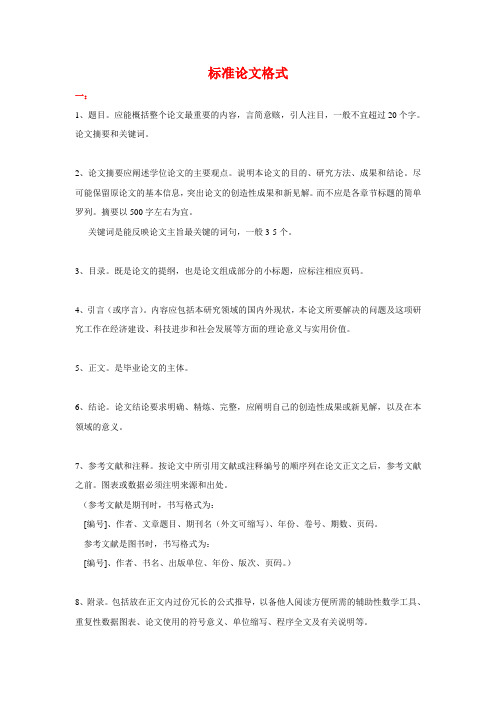
标准论文格式一:1、题目。
应能概括整个论文最重要的内容,言简意赅,引人注目,一般不宜超过20个字。
论文摘要和关键词。
2、论文摘要应阐述学位论文的主要观点。
说明本论文的目的、研究方法、成果和结论。
尽可能保留原论文的基本信息,突出论文的创造性成果和新见解。
而不应是各章节标题的简单罗列。
摘要以500字左右为宜。
关键词是能反映论文主旨最关键的词句,一般3-5个。
3、目录。
既是论文的提纲,也是论文组成部分的小标题,应标注相应页码。
4、引言(或序言)。
内容应包括本研究领域的国内外现状,本论文所要解决的问题及这项研究工作在经济建设、科技进步和社会发展等方面的理论意义与实用价值。
5、正文。
是毕业论文的主体。
6、结论。
论文结论要求明确、精炼、完整,应阐明自己的创造性成果或新见解,以及在本领域的意义。
7、参考文献和注释。
按论文中所引用文献或注释编号的顺序列在论文正文之后,参考文献之前。
图表或数据必须注明来源和出处。
(参考文献是期刊时,书写格式为:[编号]、作者、文章题目、期刊名(外文可缩写)、年份、卷号、期数、页码。
参考文献是图书时,书写格式为:[编号]、作者、书名、出版单位、年份、版次、页码。
)8、附录。
包括放在正文内过份冗长的公式推导,以备他人阅读方便所需的辅助性数学工具、重复性数据图表、论文使用的符号意义、单位缩写、程序全文及有关说明等。
二:本科毕业论文格式要求:1、装订顺序:目录--内容提要--正文--参考文献--写作过程情况表--指导教师评议表参考文献应另起一页。
纸张型号:A4纸。
A4 210×297毫米论文份数:一式三份。
其他(调查报告、学习心得):一律要求打印。
2、论文的封面由学校统一提供。
(或听老师的安排)3、论文格式的字体:各类标题(包括“参考文献”标题)用粗宋体;作者姓名、指导教师姓名、摘要、关键词、图表名、参考文献内容用楷体;正文、图表、页眉、页脚中的文字用宋体;英文用Times New Roman字体。
论文格式排版
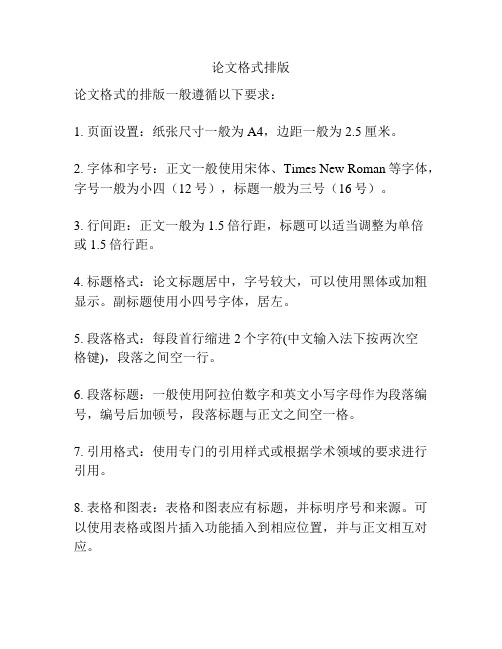
论文格式排版
论文格式的排版一般遵循以下要求:
1. 页面设置:纸张尺寸一般为A4,边距一般为
2.5厘米。
2. 字体和字号:正文一般使用宋体、Times New Roman等字体,字号一般为小四(12号),标题一般为三号(16号)。
3. 行间距:正文一般为1.5倍行距,标题可以适当调整为单倍
或1.5倍行距。
4. 标题格式:论文标题居中,字号较大,可以使用黑体或加粗显示。
副标题使用小四号字体,居左。
5. 段落格式:每段首行缩进2个字符(中文输入法下按两次空
格键),段落之间空一行。
6. 段落标题:一般使用阿拉伯数字和英文小写字母作为段落编号,编号后加顿号,段落标题与正文之间空一格。
7. 引用格式:使用专门的引用样式或根据学术领域的要求进行引用。
8. 表格和图表:表格和图表应有标题,并标明序号和来源。
可以使用表格或图片插入功能插入到相应位置,并与正文相互对应。
9. 参考文献:参考文献一般按照引用格式的规则来编写,并按照一定的顺序排列,如按作者姓氏首字母顺序或按文献出现顺序。
10. 页眉页脚:页眉页脚一般包括论文题目、页码和日期等信息。
页码要求居中显示,在正文部分使用小写罗马数字进行编号,正文之后使用阿拉伯数字进行编号。
以上是一般的论文格式排版要求,实际排版时应根据学校或期刊的具体要求进行调整。
论文格式要求及字体大小
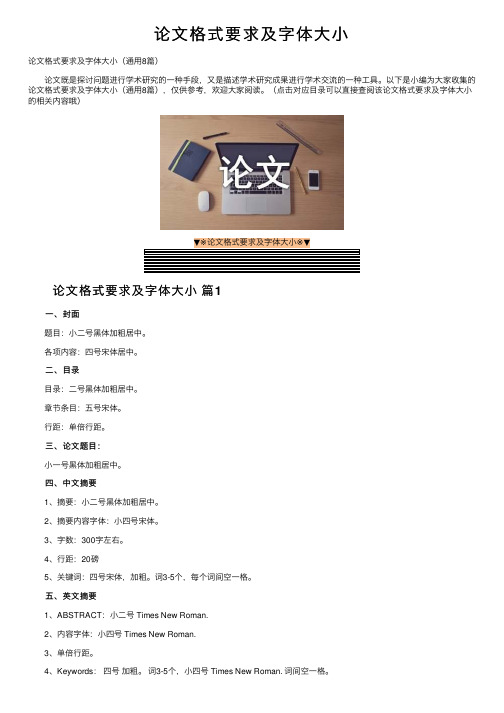
论⽂格式要求及字体⼤⼩论⽂格式要求及字体⼤⼩(通⽤8篇) 论⽂既是探讨问题进⾏学术研究的⼀种⼿段,⼜是描述学术研究成果进⾏学术交流的⼀种⼯具。
以下是⼩编为⼤家收集的论⽂格式要求及字体⼤⼩(通⽤8篇),仅供参考,欢迎⼤家阅读。
(点击对应⽬录可以直接查阅该论⽂格式要求及字体⼤⼩的相关内容哦)▼※论⽂格式要求及字体⼤⼩※▼论⽂格式要求及字体⼤⼩篇1 ⼀、封⾯ 题⽬:⼩⼆号⿊体加粗居中。
各项内容:四号宋体居中。
⼆、⽬录 ⽬录:⼆号⿊体加粗居中。
章节条⽬:五号宋体。
⾏距:单倍⾏距。
三、论⽂题⽬: ⼩⼀号⿊体加粗居中。
四、中⽂摘要 1、摘要:⼩⼆号⿊体加粗居中。
2、摘要内容字体:⼩四号宋体。
3、字数:300字左右。
4、⾏距:20磅 5、关键词:四号宋体,加粗。
词3-5个,每个词间空⼀格。
五、英⽂摘要 1、ABSTRACT:⼩⼆号 Times New Roman. 2、内容字体:⼩四号 Times New Roman. 3、单倍⾏距。
4、Keywords:四号加粗。
词3-5个,⼩四号 Times New Roman. 词间空⼀格。
六、绪论 ⼩⼆号⿊体加粗居中。
内容500字左右,⼩四号宋体,⾏距:20磅 七、正⽂ (⼀)正⽂⽤⼩四号宋体 (⼆)安保、管理类毕业论⽂各章节按照⼀、⼆、三、四、五级标题序号字体格式 章:标题⼩⼆号⿊体,加粗,居中。
节:标题⼩三号⿊体,加粗,居中。
⼀级标题序号如:⼀、⼆、三、标题四号⿊体,加粗,顶格。
⼆级标题序号如:(⼀)(⼆)(三)标题⼩四号宋体,不加粗,顶格。
三级标题序号如:1.2.3.标题⼩四号宋体,不加粗,缩进⼆个字。
四级标题序号如:(1)(2)(3)标题⼩四号宋体,不加粗,缩进⼆个字。
五级标题序号如:①②③标题⼩四号宋体,不加粗,缩进⼆个字。
医学、体育类毕业论⽂各章序号⽤阿拉伯数字编码,层次格式为:1xxxx(⼩2号⿊体,居中)xxxxxxxxxxxxxx(内容⽤4号宋体)。
论文格式要求
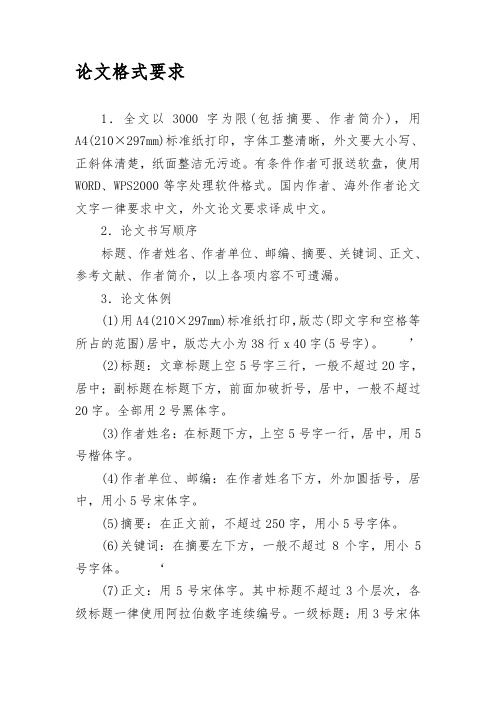
论文格式要求1.全文以3000字为限(包括摘要、作者简介),用A4(210×297mm)标准纸打印,字体工整清晰,外文要大小写、正斜体清楚,纸面整洁无污迹。
有条件作者可报送软盘,使用WORD、WPS2000等字处理软件格式。
国内作者、海外作者论文文字一律要求中文,外文论文要求译成中文。
2.论文书写顺序标题、作者姓名、作者单位、邮编、摘要、关键词、正文、参考文献、作者简介,以上各项内容不可遗漏。
3.论文体例(1)用A4(210×297mm)标准纸打印,版芯(即文字和空格等所占的范围)居中,版芯大小为38行x 40字(5号字)。
’ (2)标题:文章标题上空5号字三行,一般不超过20字,居中;副标题在标题下方,前面加破折号,居中,一般不超过20字。
全部用2号黑体字。
(3)作者姓名:在标题下方,上空5号字一行,居中,用5号楷体字。
(4)作者单位、邮编:在作者姓名下方,外加圆括号,居中,用小5号宋体字。
(5)摘要:在正文前,不超过250字,用小5号字体。
(6)关键词:在摘要左下方,一般不超过8个字,用小5号字体。
‘(7)正文:用5号宋体字。
其中标题不超过3个层次,各级标题一律使用阿拉伯数字连续编号。
一级标题:用3号宋体字,序号用阿拉伯数字(1,2,3……),顶格;二级标题:用4号黑体字,序号用两个阿拉伯数字(1·1,1.2,1.3……),用点号分开,顶格;三级标题:用5号黑体字,序号用三个阿拉伯数字(1.1.1,1.1.2,……1.2.1……),用两个点号分开,顶格。
(8)文中公式、算式和方程式均应编排序号。
计量单位和符号、缩略词应使用国家标准和国际通用符号。
文中凡表明确切数量和年月日均使用阿拉伯数字。
习惯用语和表示大意的语词可用汉字。
文中出现的外文字母和外文专用名词必须打印清楚,注意区分字体和大小写。
(9)每篇论文的图表(照片)不超过5幅,图片均应在文章中的引用处右上角加注序号。
论文的格式要求
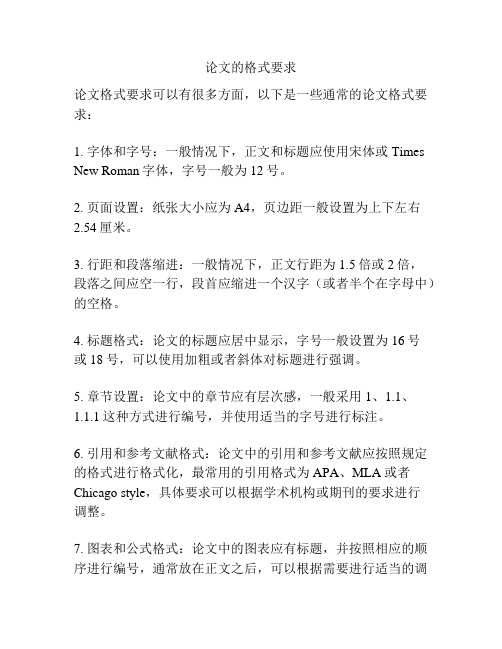
论文的格式要求
论文格式要求可以有很多方面,以下是一些通常的论文格式要求:
1. 字体和字号:一般情况下,正文和标题应使用宋体或Times New Roman字体,字号一般为12号。
2. 页面设置:纸张大小应为A4,页边距一般设置为上下左右2.54厘米。
3. 行距和段落缩进:一般情况下,正文行距为1.5倍或2倍,
段落之间应空一行,段首应缩进一个汉字(或者半个在字母中)的空格。
4. 标题格式:论文的标题应居中显示,字号一般设置为16号
或18号,可以使用加粗或者斜体对标题进行强调。
5. 章节设置:论文中的章节应有层次感,一般采用1、1.1、
1.1.1这种方式进行编号,并使用适当的字号进行标注。
6. 引用和参考文献格式:论文中的引用和参考文献应按照规定的格式进行格式化,最常用的引用格式为APA、MLA或者Chicago style,具体要求可以根据学术机构或期刊的要求进行
调整。
7. 图表和公式格式:论文中的图表应有标题,并按照相应的顺序进行编号,通常放在正文之后,可以根据需要进行适当的调
整。
公式应使用适当的标记进行编号,并在引用时进行说明。
8. 脚注和页眉页脚:脚注用于对文中某一内容进行补充说明,页眉页脚用于编写作者姓名、论文标题、页码等信息。
当然,不同的学术机构、期刊、导师等对论文格式要求可能会有所不同,所以在撰写论文之前,最好先咨询相关的指导意见或查阅具体的写作指南。
毕业论文格式标准及字数要求

毕业论⽂格式标准及字数要求毕业论⽂格式标准及字数要求 ⼀段充实⽽忙碌的⼤学⽣活即将结束,毕业前要通过最后的毕业论⽂,毕业论⽂是⼀种的检验⼤学学习成果的形式,快来参考毕业论⽂是怎么写的吧!以下是⼩编帮⼤家整理的毕业论⽂格式标准及字数要求,希望能够帮助到⼤家。
毕业论⽂格式标准及字数要求篇1 1.引⾔ 1.1毕业论⽂应采⽤最新颁布的汉语简化⽂字,符合《出版物汉字使⽤管理规定》,由作者在计算机上输⼊、编排与打印完成。
1.2毕业论⽂作者应在选题前后阅读⼤量有关⽂献,⽂献阅读量不少于10篇,将其列⼊参考⽂献表,并在正⽂中引⽤内容处注明参考⽂献编号(按出现先后顺序编排)。
2.编写要求 2.1页⾯要求:毕业论⽂须⽤A4(210×297mm)标准、70克以上⽩纸,⼀律采⽤单⾯打印;毕业论⽂页边距按以下标准设置:上边距(天头)为:30mm;下边距(地脚)25mm;左边距和右边距为:25mm;装订线:10mm;页眉:16mm;页脚:15mm。
2.2页眉:页眉从摘要页开始到论⽂最后⼀页,均需设置。
页眉内容:济宁职业技术学院毕业论⽂,居中,打印字号为5号宋体,页眉之下有⼀条下划线。
2.3页脚:从论⽂主体部分(引⾔或绪论)开始,⽤阿拉伯数字连续编页,页码编写⽅法为:第x页共x页,居中,打印字号为⼩5号宋体。
2.4前置部分从内容摘要起单独编页。
2.5字体与间距:毕业论⽂字体为⼩四号宋体,字间距设置为标准字间距,⾏间距设置为固定值20磅。
3.编写格式 3.1毕业论⽂章、节的编号:按阿拉伯数字分级编号。
3.2毕业论⽂的构成(按毕业论⽂中先后顺序排列): 前置部分:封⾯ 中⽂摘要,关键词⽬次页(必要时)主体部分:引⾔(或绪论)正⽂ 结论 致谢(必要时)参考⽂献 4.前置部分 4.1封⾯:封⾯格式按如下。
封⾯内容各项必须如实填写完整。
其中论⽂题⽬是以最恰当、最简明的词语反映毕业论⽂中最重要的特定内容的逻辑组合;论⽂题⽬所⽤每⼀词必须考虑到有助于选定关键词和编制题录、索引等⼆次⽂献可以提供检索的特定实⽤信息;论⽂题⽬⼀般不宜超过30字。
标准论文格式+要求+范文超全)
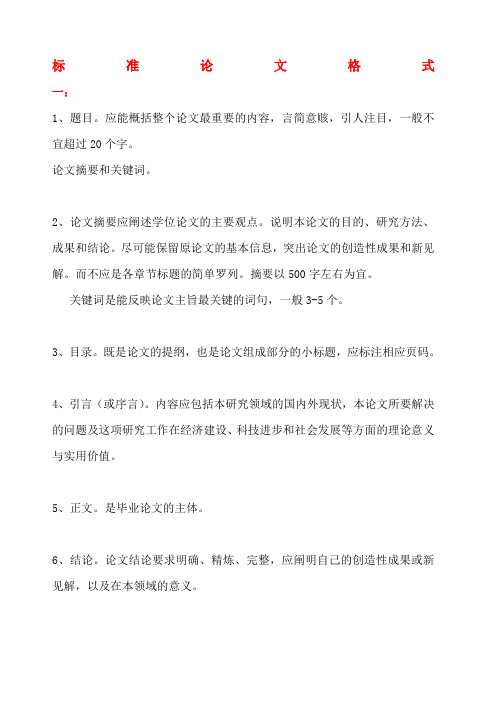
标准论文格式一:1、题目。
应能概括整个论文最重要的内容,言简意赅,引人注目,一般不宜超过20个字。
论文摘要和关键词。
2、论文摘要应阐述学位论文的主要观点。
说明本论文的目的、研究方法、成果和结论。
尽可能保留原论文的基本信息,突出论文的创造性成果和新见解。
而不应是各章节标题的简单罗列。
摘要以500字左右为宜。
关键词是能反映论文主旨最关键的词句,一般3-5个。
3、目录。
既是论文的提纲,也是论文组成部分的小标题,应标注相应页码。
4、引言(或序言)。
内容应包括本研究领域的国内外现状,本论文所要解决的问题及这项研究工作在经济建设、科技进步和社会发展等方面的理论意义与实用价值。
5、正文。
是毕业论文的主体。
6、结论。
论文结论要求明确、精炼、完整,应阐明自己的创造性成果或新见解,以及在本领域的意义。
7、参考文献和注释。
按论文中所引用文献或注释编号的顺序列在论文正文之后,参考文献之前。
图表或数据必须注明来源和出处。
(参考文献是期刊时,书写格式为:[编号]、作者、文章题目、期刊名(外文可缩写)、年份、卷号、期数、页码。
参考文献是图书时,书写格式为:[编号]、作者、书名、出版单位、年份、版次、页码。
)8、附录。
包括放在正文内过份冗长的公式推导,以备他人阅读方便所需的辅助性数学工具、重复性数据图表、论文使用的符号意义、单位缩写、程序全文及有关说明等。
二:本科毕业论文格式要求:1、装订顺序:目录--内容提要--正文--参考文献--写作过程情况表--指导教师评议表参考文献应另起一页。
纸张型号:A4纸。
A4 210×297毫米论文份数:一式三份。
其他(调查报告、学习心得):一律要求打印。
2、论文的封面由学校统一提供。
(或听老师的安排)3、论文格式的字体:各类标题(包括“参考文献”标题)用粗宋体;作者姓名、指导教师姓名、摘要、关键词、图表名、参考文献内容用楷体;正文、图表、页眉、页脚中的文字用宋体;英文用Times New Roman字体。
论文格式要求

论文格式要求
1.论文字数在3000-3500之间,包含题目、摘要、正文及参考文献。
2.论文标题采用宋体小三号,加黑居中,不得超过20字。
3.题目下方另起一行写上专业班级、姓名、学号,黑体五号,居中。
4.摘要在150-200之间,概括论文正文内容,简单介绍论文的写作
意图及论文的意义。
“摘要”二字仿宋小四号加黑,顶格。
摘要正文仿宋小四号,行距1.25倍。
段前段后0.5行。
5.关键词在3-5个之间,“关键词”三字仿宋小四号加黑,顶格。
关键词语仿宋小四号,行距1.25倍,段前段后0.5行,以逗号间隔。
6.论文一级标题宋体四号加黑,顶格,段前1行,段后0.5行;二
级标题宋体小四号加黑,顶格,段前0.5行,段后0.5行。
7.正文文字宋体小四号,首行缩进2字符,行距1.25倍。
8.表格要有表头,插图要有图示。
表头和图示字体黑体五号,居中,
单倍行距。
9.参考文献1-3个,位于论文篇幅末端,仿宋小四,顶格,1.25倍
行距。
正式论文格式要求

正式论文格式要求【篇一:正规论文格式模板】全文1.5倍行距标题标题标题标题(二号宋体,居中,加粗)【说明:?标题是能反映论文中特定内容的恰当、简明的词语的逻辑组合,应避免使用含义笼统、泛指性很强的词语(一般不超过20字,必要时可加副标题,尽可能不用动宾结构,而用名词性短语,也不用“??的研究”,“基于??”)。
】作者11 (四号楷体,居中)【说明:摘要应具有独立性和自含性,即不阅读全文,就能获得必要的信息。
要使用科学性文字和具体数据,不使用文学性修饰词;不使用图、表、参考文献、复杂的公式和复杂的化学式,非公知公用的符号或术语;不要加自我评价,如“该研究对?有广阔的应用前景”,“目前尚未见报道”等。
摘要能否准确、具体、完整地概括原文的创新之处,将直接决定论文是否被收录、阅读和引用。
摘要长度200~300字。
摘要一律采用第三人称表述,不使用“本文”、“文章”、“作者”、“本研究”等作为主语。
】关键词:(小五号黑体,缩进两格)关键词;关键词;关键词;关键词(小五号楷体,全角分号隔开)【说明:关键词是为了便于作文献索引和检索而选取的能反映论文主题概念的词或词组,每篇文章标注3~8个关键词,词与词之间用全角分号隔开。
中文关键词尽量不用英文或西文符号。
注意:关键词中至少有两个来自ei控词表。
一般高校数字图书馆均可查到。
】中图分类号:(小五号黑体,缩进两格)tm 344.1(小五号times new roman体,加粗) 文献标志码:(小五号黑体,前空四格)a(小五号times new roman体,加粗)【说明:请查阅中国图书馆分类法(第4版)(一般要有3位数字,如tm 344.1)】引言(四号宋体,加粗,顶格)引言引言引言引言引言引言引言引言引言引言引言引言引言引言引言引言引言引言引言引言引言引言引言引言引言引言引言引言引言引言引言引言引言引言引言引言引言引言引言引言引言引言引言引言引言引言引言引言引言引言引言引言??(五号宋体,段前前缩进两格)【说明:引言作为论文的开端,主要回答“为什么研究”这个问题。
论文的格式要求

论文的格式要求:1. 论文分【封面】、【指导老师评语】、【中文摘要、关键词】、【英文摘要、关键词】、【目录】、【正文】、【参考文献】这几个部分,排版时按以上顺序排版,各部分要另起一页进行。
2. 插入页码的要求:正文页码和正文之前部分的页码要分开标记(插入分节符),【封面】和【指导老师评语】不加页码。
3. 摘要、关键词部分:(1)摘要”二字居中,“关键词”不用,左起写就可以了;(2)中英文摘要、关键词的内容不加粗;(3)英文关键字注意每个单词的开头都得是大写,而不只是在词组的开头写;英文关键词之间用分号分开,最后一个关键词后不用加分号;(4)中英文摘要、关键词的字体可以适当加大以使页面较为饱满(但字体不要过大)。
4. 目录部分:(1)“目录”二字居中;目录部分的字体和字号要统一;(2)引言不要写在目录里;(3)目录中不要出现括号、句号、叹号等标点;(4)建议使用word的目录生成功能(在正文的各个段落的【段落】格式属性中可以设置【大纲级别】为【1级】、【2级】等标题等级;在设置好段落的【大纲级别】后在目录页使用【插入】-【引用】-【引索和目录】生成目录,再对目录各标题内容进行编辑);(5)目录中的字体不能是斜体,自动生成的如果是斜体要改正。
5. 正文部分:(1)正文内容统一使用五号字体,标题可以适当扩大,不扩大的话也要加黑,要和正文有所区分;(2)各标题和标题下内容间隔不要过大(在正文部分使用1.5倍行距时,标题和内容不要再隔一行);(3)一级标题居中,“一”后面加顿号,如“一、”;二级标题顶格写,后面什么符号也不要有;三级标题空两个格,后面是原点,如“1.”(4)正文中有图表的,表头要居中(不要在表格里面),表下方要写资料来源,左起空两个格写;(5)正文中有引言的,“引言”二字当做一级标题处理,“引言”前面不要加“一、”。
6. 参考文献部分:参考文献要另起一页;“参考文献”四个字居中论文格式1.论文格式——题目:题目应当简明、具体、确切地反映出本文的特定内容,一般不宜超过20字,如果题目语意未尽,用副题补充说明。
论文基本格式要求及规范
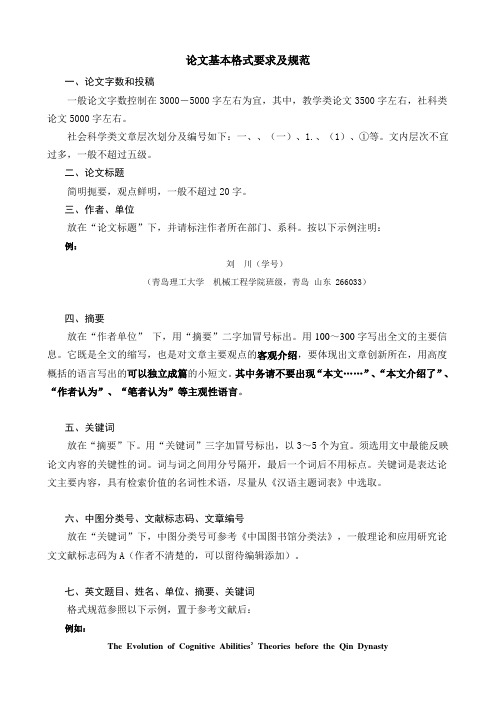
论文基本格式要求及规范一、论文字数和投稿一般论文字数控制在3000-5000字左右为宜,其中,教学类论文3500字左右,社科类论文5000字左右。
社会科学类文章层次划分及编号如下:一、、(一)、1.、(1)、①等。
文内层次不宜过多,一般不超过五级。
二、论文标题简明扼要,观点鲜明,一般不超过20字。
三、作者、单位放在“论文标题”下,并请标注作者所在部门、系科。
按以下示例注明:例:刘川(学号)(青岛理工大学机械工程学院班级,青岛山东 266033)四、摘要放在“作者单位”下,用“摘要”二字加冒号标出。
用100~300字写出全文的主要信息。
它既是全文的缩写,也是对文章主要观点的客观介绍,要体现出文章创新所在,用高度概括的语言写出的可以独立成篇的小短文。
其中务请不要出现“本文……”、“本文介绍了”、“作者认为”、“笔者认为”等主观性语言。
五、关键词放在“摘要”下。
用“关键词”三字加冒号标出,以3~5个为宜。
须选用文中最能反映论文内容的关键性的词。
词与词之间用分号隔开,最后一个词后不用标点。
关键词是表达论文主要内容,具有检索价值的名词性术语,尽量从《汉语主题词表》中选取。
六、中图分类号、文献标志码、文章编号放在“关键词”下,中图分类号可参考《中国图书馆分类法》,一般理论和应用研究论文文献标志码为A(作者不清楚的,可以留待编辑添加)。
七、英文题目、姓名、单位、摘要、关键词格式规范参照以下示例,置于参考文献后:例如:The Evolution of Cognitive Abilities’Theories before the Qin DynastyXIE Yi-an(Suzhou Vocationai University, Suzhou 215104, China)Abstract:Key words: pre-Qin Dynasty; congnitive abilities; sensory organs; Heart八、注释标注规则注释是对论著正文中某一特定内容的进一步解释或补充说明,以及未公开发表的私人通信、内部资料、书稿和仅有中介文献信息的“转引自”等文献的引用著录,一般放在该页页脚(即采取脚注形式)。
论文格式要求大全
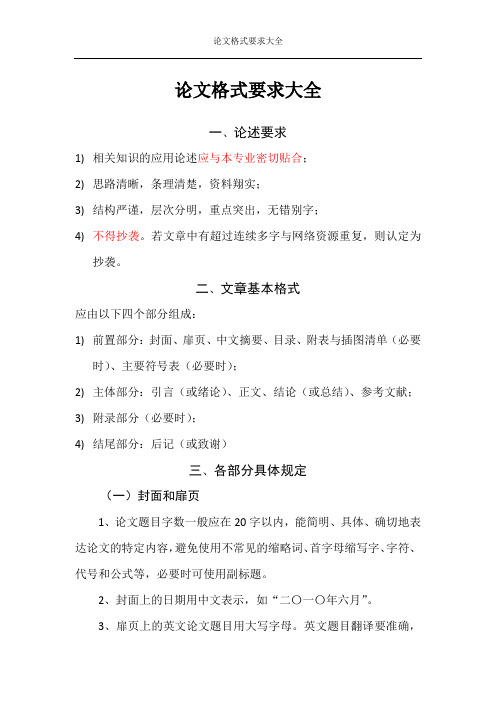
论文格式要求大全一、论述要求1)相关知识的应用论述应与本专业密切贴合;2)思路清晰,条理清楚,资料翔实;3)结构严谨,层次分明,重点突出,无错别字;4)不得抄袭。
若文章中有超过连续多字与网络资源重复,则认定为抄袭。
二、文章基本格式应由以下四个部分组成:1)前置部分:封面、扉页、中文摘要、目录、附表与插图清单(必要时)、主要符号表(必要时);2)主体部分:引言(或绪论)、正文、结论(或总结)、参考文献;3)附录部分(必要时);4)结尾部分:后记(或致谢)三、各部分具体规定(一)封面和扉页1、论文题目字数一般应在20字以内,能简明、具体、确切地表达论文的特定内容,避免使用不常见的缩略词、首字母缩写字、字符、代号和公式等,必要时可使用副标题。
2、封面上的日期用中文表示,如“二〇一〇年六月”。
3、扉页上的英文论文题目用大写字母。
英文题目翻译要准确,合乎语法规范。
(二)中文摘要1、摘要是对文章内容不加注释和评论的简短陈述,具有独立性和自含性,即不阅读论文全文,就能获得必要的信息。
摘要应突出作者的论点,尤其是具有创新性的成果和新见解。
除了实在无变通办法可用外,摘要中不得使用图、表、化学结构式、非公知公用的符号和术语。
摘要内容不要写成说明性的介绍,如“本文分几章,第一章说明课题来源,最后一章给出了全文结论,提出了今后研究方向等”。
2、关键词是为了便于做文献索引和检索工作而从论文中选取出来用以表示全文主题内容信息的单词或术语,一般为3~5个。
3、中文摘要为300字左右(三)目录目录由论文的章节以及中文摘要、英文摘要、参考文献、附录、后记(或致谢)、题名和页码组成。
(四)插图和附表清单如果文章的插图和附表太多,可以分别列出清单,置于目录之后。
插图清单包括图号、图题及其页码;附表清单包括表号、表题及其页码。
(五)主要符号表符号、标志、缩略语、首字母缩写、计量单位、名词、术语等的注释说明,如需汇集,可集中置于图表清单之后。
论文格式要求
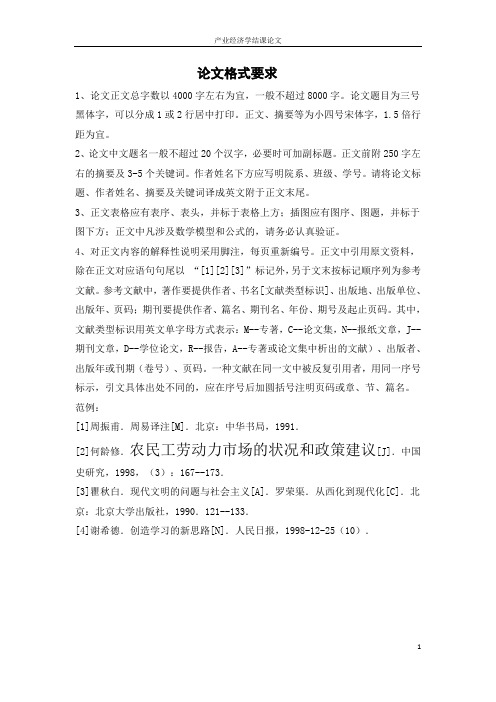
论文格式要求1、论文正文总字数以4000字左右为宜,一般不超过8000字。
论文题目为三号黑体字,可以分成1或2行居中打印。
正文、摘要等为小四号宋体字,1.5倍行距为宜。
2、论文中文题名一般不超过20个汉字,必要时可加副标题。
正文前附250字左右的摘要及3-5个关键词。
作者姓名下方应写明院系、班级、学号。
请将论文标题、作者姓名、摘要及关键词译成英文附于正文末尾。
3、正文表格应有表序、表头,并标于表格上方;插图应有图序、图题,并标于图下方;正文中凡涉及数学模型和公式的,请务必认真验证。
4、对正文内容的解释性说明采用脚注,每页重新编号。
正文中引用原文资料,除在正文对应语句句尾以“[1][2][3]”标记外,另于文末按标记顺序列为参考文献。
参考文献中,著作要提供作者、书名[文献类型标识]、出版地、出版单位、出版年、页码;期刊要提供作者、篇名、期刊名、年份、期号及起止页码。
其中,文献类型标识用英文单字母方式表示:M--专著,C--论文集,N--报纸文章,J--期刊文章,D--学位论文,R--报告,A--专著或论文集中析出的文献)、出版者、出版年或刊期(卷号)、页码。
一种文献在同一文中被反复引用者,用同一序号标示,引文具体出处不同的,应在序号后加圆括号注明页码或章、节、篇名。
范例:[1]周振甫.周易译注[M].北京:中华书局,1991.[2]何龄修.农民工劳动力市场的状况和政策建议[J].中国史研究,1998,(3):167--173.[3]瞿秋白.现代文明的问题与社会主义[A].罗荣渠.从西化到现代化[C].北京:北京大学出版社,1990.121--133.[4]谢希德.创造学习的新思路[N].人民日报,1998-12-25(10).推进天津滨海新区开发开放,促进京津一体化发展邢春生①天津滨海综合发展研究院[摘要]京津合作既有广阔前景,又有各种制约,滨海新区开发开放将对京津合作产生四个方面的积极影响:推动了京津经济互补发展,加速了京津基础设施对接,增强了京津经济发展的协调性,优化了京津对资源的再配置。
论文格式要求

毕业论文格式要求
1、论文标题用宋体二号或小二号,一般不超过20个字,位置居中;
必要时可加副标题,用楷体四号,前加两个字长度的横线。
2、作者名字用仿宋四号,位置居中。
系别用宋体五号,位置居中,写为“××系××专业”,加圆括号
3、“摘要”用黑体五号,前面留两个字长度的空白,“摘要”两个字中间留一个字长度的空
白,后加冒号;摘要内容用楷体五号。
4、“关键词”用黑体五号,前面留两个字长度的空白,后加冒号;中间空格隔开,结尾不需加句号;关键词内容用楷体五号。
5、正文用宋体小四号;
正文中的小标题逐级为黑体三号、四号、小四号。
(注意序号级别)
一、(一) 1、(1)①
“注释内容用宋体五号,题号用”①②③……
6、“参考文献”用黑体五号,后加冒号,然后另起一行为
参考文献内容;每条内容题号用[1][2][3]……,
后面依次为作者;书名/文章标题;出版社/报刊名;出版年月/报刊年份、期号,均用宋题五号。
[序号]主要责任者.文献题名:其他题名信息(任选)[文献类型标识].其他责任者(任选).版本项(任选).出版地:出版者,出版年:起止页码(当整体引用时不注).
如
参考文献:
[1]余敏.数学教学研究[M].北京:中国书籍出版社,2001.
[2]李晓东.气候学研究的若干理论问题[J].北京大学学报:自然科学版,1993.
……标题
作者名字
(教育与人文学院 11数学教育班)摘要:……(写你自己的教学设计内容摘要要求150字左右)关键词:(出现频率多的次,重要的词语,关键词3~5个)。
论文的标准格式(最新8篇)
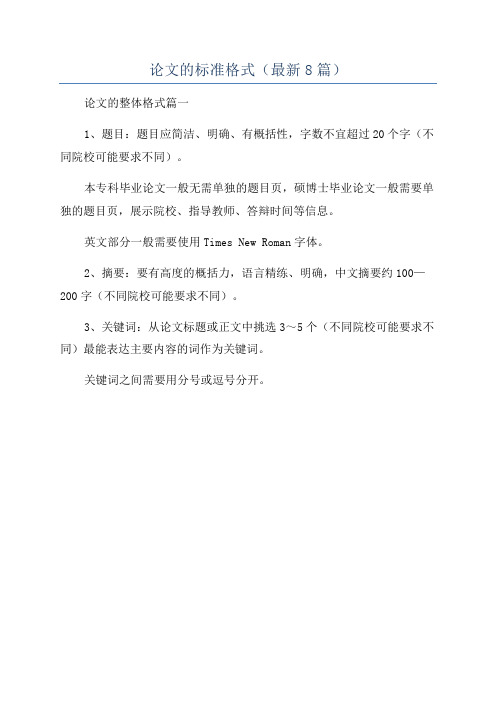
论文的标准格式(最新8篇)
论文的整体格式篇一
1、题目:题目应简洁、明确、有概括性,字数不宜超过20个字(不同院校可能要求不同)。
本专科毕业论文一般无需单独的题目页,硕博士毕业论文一般需要单独的题目页,展示院校、指导教师、答辩时间等信息。
英文部分一般需要使用Times New Roman字体。
2、摘要:要有高度的概括力,语言精练、明确,中文摘要约100—200字(不同院校可能要求不同)。
3、关键词:从论文标题或正文中挑选3~5个(不同院校可能要求不同)最能表达主要内容的词作为关键词。
关键词之间需要用分号或逗号分开。
论文格式要求

论⽂格式要求
论⽂格式要求
现如今,⼤家都不可避免地要接触到论⽂吧,借助论⽂可以有效训练我们运⽤理论和技能解决实际问题的的能⼒。
相信许多⼈会觉得论⽂很难写吧,以下是⼩编为⼤家整理的论⽂格式要求,欢迎阅读与收藏。
论⽂格式要求1
附件2
格式要求
1、书写语⾔、字数及版式。
书写语⾔为中⽂,字数1般不超过5000字,其中摘要不超
过250字,⽤A4纸打印。
2、⽂稿录⼊。
提供电⼦⽂件和打印稿。
3、书写顺序。
标题、作者姓名、作者单位详细名称、单位所在地(市、县)、邮编、摘要、关键词、正⽂、参考⽂献、作者简介。
4、格式及字体字号
◆标题居中,3号⿊体;
◆作者单位:⼩5号宋体居中;
◆作者姓名:5号楷体居中;
◆摘要:⼩5号宋体;
◆关键词:⼩5号宋体,1般不超过5个词;
◆正⽂:5号宋体:
◆正⽂序号1般不超过3个层次,即:
第1层标题,4号⿊体,从左边空2个字;
第2层标题,⼩4号⿊体,从左边空2个字,下⽂另起⾏:
第3层标题或段⾸标题,5号⿊体,从左边空2个字,正⽂另起⾏或接排;
以下层次⽤a、b、c……表述。
◆表头:5号⿊体居中:
◆表中⽂字:⼩5号宋体;。
- 1、下载文档前请自行甄别文档内容的完整性,平台不提供额外的编辑、内容补充、找答案等附加服务。
- 2、"仅部分预览"的文档,不可在线预览部分如存在完整性等问题,可反馈申请退款(可完整预览的文档不适用该条件!)。
- 3、如文档侵犯您的权益,请联系客服反馈,我们会尽快为您处理(人工客服工作时间:9:00-18:30)。
Formatting a Paper for the SPE Paper Contest Qualifier of Chengdu Study Group SectionPl ease take the SPE Publications Style Guide given below as a standard in writing English papers for The SPE Paper Contest Qualifier of Chengdu Study Group Section. We may cancel your right to participant in the contest if there are so many differences betweenthe paper you send to us and the format paper.The SPE Publications Style Guid e provides information on the SPE style for elements in technical papers. Our contest refers to parts of <Formatting a Paper for Peer Review> as our paper formatting requirement.●Length of the paper: Each paper is limited to 10 pages normally, and additionalpages will be charged. If your paper is too l ong, you can shrink the size of yourgraphics. No alterations to page layout or formation are all owed. Before usingevery trick you know to make your paper a certain l ength, try cutting textinstead or (if all owed) paying the extra page charge.●The paper should be created in MS word and saved as “Word 97-2003” formationfor the PC.●The paper should be single column, 1.25 -spaced, with text in 10-point type onA4 paper.●Margin :a. Top: 2.54 cm; b. Left : 3.18 cm; c. Right : 3.18 cm; d. Bottom : 2.54 cm●Authors: List the authors under the title in the order you want them to appear.Include the name and company affiliation of each author. Put SPE after thenames of authors who are SPE members. Example: Joe Smith, SPE, GenericPetroleum Co.●Summary: Include a summary of 50 to 100 words at the beginning of the paper.●Headings and Subheads: Make sure that major headings, subheads, andsub-subheads are clearly distinguishable by using the foll owing styles:○First-Level Headings – 10-point bold on line by itself.○Second-Level Headings – 10-point bold, period at end, and run into the next paragraph.○Third-Level Headings – 10-point bold italic, period at end, and run into next paragraph.○Fourth-Level Headings – 10-point italic, period at end, and run into next paragraph.●References: Cite references in the text by placing the author's name and year inparentheses; then, includ e an alphabetical listing of the references at the end of the paper. [Note: this is a change from SPE's previous reference style, whichrequired references to be numbered in the order in which they were cited.]●Numbering Figures and Tabl es: Number figures and tabl es (in Arabic, notRoman, numerals) sequentially in the order they are cited in the text. Avoidnumbering individual figures as Fig. 11a and Fig. 11b. Instead, make them Fig.11 and Fig. 12.●Numbering Equations: Number equations sequentially as they appear in thepaper. Enclose the equation number in parentheses preceded by a line of d ots (see SPE Publications Style Guide Sec. 8.5.1).●Nomenclature: If symbols for quantities (e.g., p for pressure or q for flow rate)are used in the text, equations, tabl es, or figures, include a Nomenclatured efining them at the end of the text. The Nomenclature should list the symbol,the d efinition, the units of measure (or dimensionl ess), and the dimensions (see SPE Publications Style Guide sec. 8.7.4). Also availabl e is the SPE Letter andComputer Symbols Standard which provides a list on commonly used symbols and their d efinition.●Reference List: Include complete information on all references in the formatd escribed in Sec. 8.8 of the SPE Publications Style Guide. Incomplete referencecitations may result in your paper being returned for correction and a delay in publication.●Metric Conversion Factors: After the References section, include metricconversion factors for units used (see SPE Publications Style Guide, Sec. 8.10.3).The metric conversion factors should go from customary units to metric units.●Author Biographies: Provide a brief biographical sketch of each author at theend of the paper. For each author, give only the name, title, company ororganization, location of the company or organization, work history, andeducation history. Including an email ad dress is suggested but not required.●Tabl es and Figures: All tabl es and figures should be cited sequentially in thetext of the paper. They should be grouped at the end of the paper rather than embedd ed in the text. Please include figure captions in a listing at the end of the text. In addition, please format tabl es using the Tabl e menu on the MS Wordtoolbar; tabl es should not be submitted as images. Figures can be submitted in Word, Excel, or PowerPoint format, or as .tif or .jpg images. Images submitted graphically need to be print-quality (300 dpi) not web-quality (72 px/inch).●Col or Figures: SPE no l onger charges extra to print figures in col or. Sopl ease use color as appropriate in figure illustrating your results.。
